
Pharaoh is the common title now used for the monarchs of ancient Egypt from the First Dynasty until the annexation of Egypt by the Roman Empire in 30 BCE, although the term "pharaoh" was not used contemporaneously for a ruler until Merneptah, c. 1210 BCE, during the Nineteenth dynasty, "king" being the term used most frequently until the middle of the Eighteenth Dynasty. In the early dynasties, ancient Egyptian kings used to have up to three titles: the Horus, the Sedge and Bee (nswt-bjtj), and the Two Ladies or Nebty (nbtj) name. The Golden Horus as well as the nomen and prenomen titles were added later.

Aten also Aton, Atonu, Itn was the focus of Atenism, the religious system established in ancient Egypt by the Eighteenth Dynasty pharaoh Akhenaten. The Aten was the disc of the sun and originally an aspect of Ra, the sun god in traditional ancient Egyptian religion, but Akhenaten made it the sole focus of official worship during his reign.

Ay II, commonly known just as Ay, was the penultimate pharaoh of ancient Egypt's 18th Dynasty. He held the throne of Egypt for a brief four-year period, although he was a close advisor to two and perhaps three of the pharaohs who ruled before him and is thought to have been the power behind the throne during Tutankhamun's reign. Ay's prenomen or royal name—Kheperkheperure—means "Everlasting are the Manifestations of Ra" while his nomenAy it-netjer reads as "Ay, Father of the God". Records and monuments that can be clearly attributed to Ay are rare, not only due to his short length of reign, but also because his successor, Horemheb, instigated a campaign of damnatio memoriae against him and other pharaohs associated with the unpopular Amarna Period.
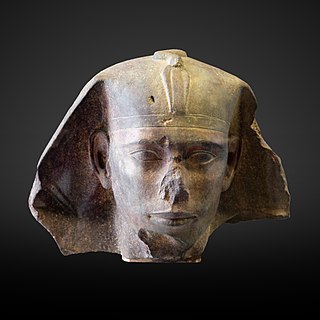
Djedefre was an ancient Egyptian king (pharaoh) of the 4th Dynasty during the Old Kingdom. He is well known by the Hellenized form of his name Rhatoisēs (Ῥατοίσης) by Manetho. Djedefre was the son and immediate throne successor of Khufu, the builder of the Great Pyramid of Giza; his mother is not known for certain. He is the king who introduced the royal title Sa-Rê and the first to connect his cartouche name with the sun god Ra.

The Fourth Dynasty of ancient Egypt is characterized as a "golden age" of the Old Kingdom of Egypt. Dynasty IV lasted from c. 2613 to 2494 BC. It was a time of peace and prosperity as well as one during which trade with other countries is documented.
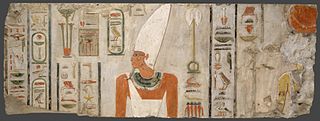
Mentuhotep II, also known under his prenomen Nephepetre, was an ancient Egyptian pharaoh circa 2061–2010 BCE, the sixth ruler of the Eleventh Dynasty. He is credited with reuniting Egypt, thus ending the turbulent First Intermediate Period and becoming the first pharaoh of the Middle Kingdom. He reigned for 51 years, according to the Turin King List. Mentuhotep II succeeded his father Intef III on the throne and was in turn succeeded by his son Mentuhotep III.
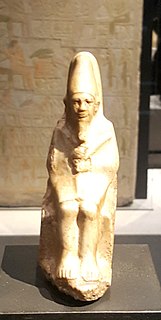
Nynetjer is the Horus name of the third pharaoh of the Second Dynasty of Egypt. The length of his reign is unknown. The Turin Canon suggests an improbable reign of 96 years and Egyptian historian Manetho suggested that Nynetjer's reign lasted 47 years. Egyptologists question both statements as misinterpretations or exaggerations. They generally credit Nynetjer with a reign of either 43 years or 45 years. Their estimation is based on the reconstructions of the well known Palermo Stone inscription reporting the years 7–21, the Cairo Stone inscription reporting the years 36–44. According to different authors, Nynetjer ruled Egypt from c. 2850 BC to 2760 BC or later from c. 2760 BC to 2715 BC.

Userkaf was a pharaoh of ancient Egypt and the founder of the Fifth Dynasty. He reigned for seven to eight years in the early 25th century BC, during the Old Kingdom period. He probably belonged to a branch of the Fourth Dynasty royal family, although his parentage is uncertain; he could have been the son of Khentkaus I. He had at least one daughter and very probably a son, Sahure, with his consort Neferhetepes. This son succeeded him as pharaoh.

Neferirkare Kakai was an ancient Egyptian pharaoh, the third king of the Fifth Dynasty. Neferirkare, the eldest son of Sahure with his consort Meretnebty, was known as Ranefer A before he came to the throne. He acceded the day after his father's death and reigned for eight to eleven years, sometime in the early to mid-25th century BCE. He was himself very likely succeeded by his eldest son, born of his queen Khentkaus II, the prince Ranefer B who would take the throne as king Neferefre. Neferirkare fathered another pharaoh, Nyuserre Ini, who took the throne after Neferefre's short reign and the brief rule of the poorly known Shepseskare.

Nebra or Raneb is the Horus name of the second early Egyptian king of the 2nd Dynasty. The exact length of his reign is unknown since the Turin canon is damaged and the year accounts are lost. Manetho suggests that Nebra's reign lasted 39 years, but Egyptologists question Manetho's view as a misinterpretation or exaggeration of information that was available to him. They credit Nebra with either a 10- or 14-year rule.
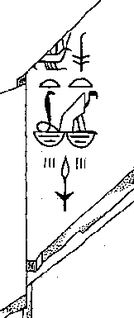
Weneg, also known as Weneg-Nebty, is the throne name of an early Egyptian king, who ruled during the Second Dynasty. Although his chronological position is clear to Egyptologists, it is unclear for how long King Weneg ruled. It is also unclear as to which of the archaeologically identified Horus-kings corresponds to Weneg.

Senakhtenre Ahmose was the seventh king of the Seventeenth Dynasty of Egypt during the Second Intermediate Period. Senakhtenre reigned for a short period over the Theban region in Upper Egypt at a time where the Hyksos 15th Dynasty ruled Lower Egypt. Senakhtenre died c.1560 or 1558 BC at the latest.
The royal titulary or royal protocol is the standard naming convention taken by the pharaohs of ancient Egypt. It symbolises worldly power and holy might and also acts as a sort of mission statement for the reign of a monarch.

Apepi or Apophis was a ruler of Lower Egypt during the Fifteenth Dynasty and the end of the Second Intermediate Period that was dominated by this foreign dynasty of rulers called the Hyksos. According to the Turin Canon of Kings, he ruled over the northern portion of Egypt for forty years. He ruled during the early half of the 16th century BC and outlived his southern rival, Kamose, but not Ahmose I. Although his reign only entailed northern Egypt, Apepi was dominant over most of Egypt during the early portion of his reign, and traded peacefully with the native Theban Seventeenth dynasty to the south.
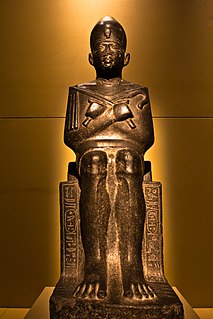
Merhotepre Sobekhotep was an Egyptian king of the 13th Dynasty during the Second Intermediate Period. According to egyptologist Kim Ryholt he was the thirtieth pharaoh of the dynasty, while Darrell Baker believes instead that he was its twenty-ninth ruler. In older studies, Jürgen von Beckerath and Detlef Franke identified Merhotepre Sobekhotep with Merhotepre Ini, thereby making him Sobekhotep VI and the twenty-eighth ruler of the 13th Dynasty.
Amun was a major ancient Egyptian deity who appears as a member of the Hermopolitan Ogdoad. Amun was attested from the Old Kingdom together with his wife Amaunet. With the 11th Dynasty, Amun rose to the position of patron deity of Thebes by replacing Montu.
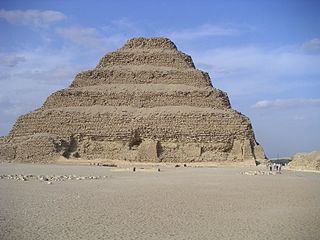
The Third Dynasty of ancient Egypt is the first dynasty of the Old Kingdom. Other dynasties of the Old Kingdom include the Fourth, Fifth and Sixth. The capital during the period of the Old Kingdom was at Memphis.

Bikheris is the Hellenized name of an ancient Egyptian pharaoh, who may have ruled during the 4th Dynasty around 2570 BC. Next to nothing is known about this ruler and some Egyptologists even believe him to be fictitious.

Netjerkare Siptah was an ancient Egyptian pharaoh, the seventh and last ruler of the Sixth Dynasty. Alternatively some scholars classify him as the first king of the Seventh or Eighth Dynasty. As the last king of the 6th Dynasty, Netjerkare Siptah is considered by some Egyptologists to be the last king of the Old Kingdom period.
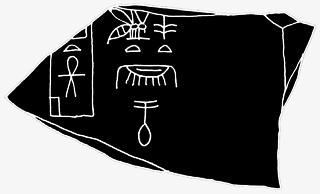
The prenomen, cartouche name or throne name of ancient Egypt was one of the five royal names of pharaohs. The first pharaoh to have a Sedge and Bee name was Den during the First Dynasty.


















